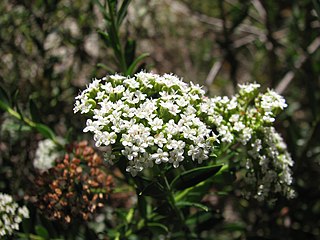
Littorina is a genus of small sea snails, marine gastropod molluscs in the family Littorinidae, the winkles or periwinkles.
Ampelocalamus is a genus of Asian bamboo in the grass family). It is found mostly in Southern China, with some species in the eastern Himalayas and northern Indochina.
Bonia is a genus of Chinese and Vietnamese bamboos in the grass family.

Minuartia is a genus of flowering plants commonly known as sandworts in the family Caryophyllaceae.

Rubus saxatilis, or stone bramble, is a species of bramble widespread across Europe and Asia from Iceland and Spain east as far as China. It has also been found in Greenland.

Platysace is a genus of woody perennial herbs and subshrubs in the family Apiaceae. The genus is endemic to Australia.

Aurinia saxatilis is an ornamental plant native to Asia and Europe.

Blumea is a genus of flowering plants of the family Asteraceae.

Eremogone cliftoniii is a species of flowering plant in the family Caryophyllaceae known by the common name Clifton's eremogone. It is endemic to California, where it is known from 27 to 33 occurrences in Butte and Plumas Counties. It occurs in forests and chaparral habitat on weathered granite soils. Although limited in distribution it may be relatively abundant where it does occur. The plant was only described to science in 2007.

Carex saxatilis is a species of sedge known by the common names rock sedge and russet sedge.

Tulipa saxatilis is a Greek and Turkish species of plants in the genus Tulipa of the family Liliaceae.

Parmelia saxatilis, commonly known as the salted shield lichen or crottle, is a species of foliose lichen in the family Parmeliaceae.

Mimetes saxatilis or limestone pagoda is an evergreen, upright, rarely branching shrub of 1–2¼ m high, assigned to the family Proteaceae. The approximately oval leaves are 3½–5 cm (1.4–2.0 in) long and 1½–3 cm (0.6–1.2 in) wide with a blunt, thickened, reddish tip or with three crowded teeth. It has cylinder-shaped inflorescences topped by a crest of green leaves, further consisting of heads with 12-22 individual bright yellow flowers, each in the axil of a flat, green leaf. It is an endemic species that is restricted to limestone outcrops in the Agulhas plains in the very south of the Western Cape province of South Africa. It is considered an endangered species. Flowering may occur between July and December, but is unreliable in its timing, dependent on sufficient moisture availability.
Stillingia saxatilis is a species of flowering plant in the family Euphorbiaceae. It was described in 1874 by Johannes Müller Argoviensis. It is native to Brazil, in Bahia and Minas Gerais.

Eremogone is a genus of flowering plants in the family Caryophyllaceae, native to western North America, northern Asia, eastern Europe and northeastern Africa. Attempts to resolve taxonomic relationships within the Caryophyllaceae have resulted in the enlargement of Eremogone with species from other genera.
Astilbe glaberrima, called the florist's spiraea and smooth rock astilbe, is a species of flowering plant in the genus Astilbe, native to Yakushima Island, Japan. Some authorities have it as a subspecies of Astilbe japonica, Astilbe japonica subsp. glaberrima. Its dwarf variety Astilbe glaberrima var. saxatilis has gained the Royal Horticultural Society's Award of Garden Merit.
Tschulaktavia is a genus of flowering plants belonging to the family Apiaceae.
Anisadenia is a genus of flowering plants belonging to the family Linaceae.












